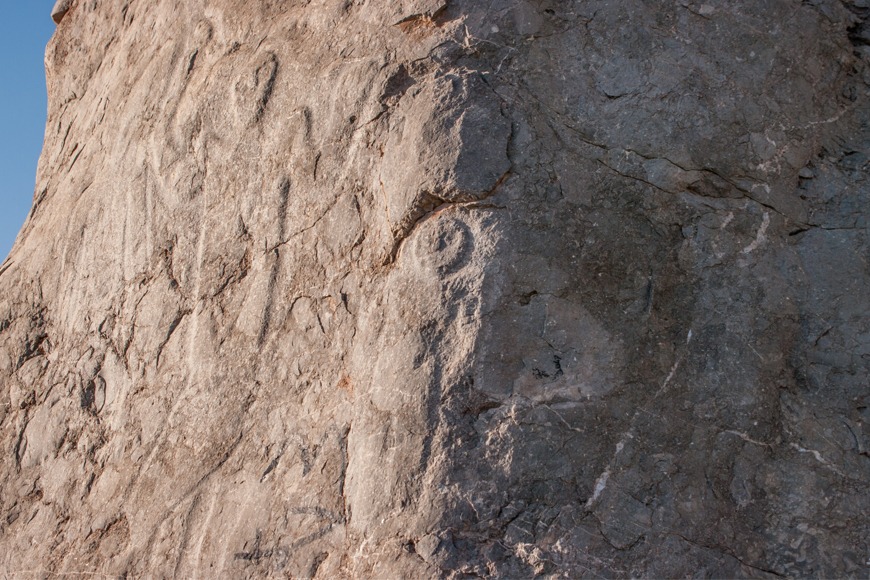Oman's long history follows a rich archaeological record from the time humans first travelled out of Africa
27 October 2019
| Last updated on 28 October 2019
Its settlements are nearly as old as other international historical sites such as the Stonehedge...
It's no surprise that Oman boasts a rich historical record. Located in the south-east corner of the Arab Peninsula and facing Iran, the Arabian Sea, and India, the nation has seen centuries of change, migration, and Persian, British, and Portuguese influence between 8 - 13 BC.
Archaeology in Oman began in the 1970s and to this day more and more historical finds are being unearthed among its colourful landscapes.
Ahead, we delve into the country's history with a guide to archaeological sites across Oman that any history buff, archeologist, or tourist should visit.
Wadi Al Ayn Tombs
- Location: Wadi Al Ayn
- Estimated age: 3100 - 1250 BCE
These 21 tombs date back to the Hafit period, which is the earliest period in Oman’s Bronze Age. Built in limestone beehive-like structures, they're located in a near-straight line atop high rocky hills in the northern part of Wadi Al Ayn and can house up to 30 people each.
The tombs measure 5 metres and have a triangular entrance that faces towards the east side.
Al Manzafah
- Location: Wilayt Ibra in A'Sharqiyah North Governorate
- Estimated age: Unknown
One of Oman's most prominent cultural landmarks, Al Manzafah features old towers, forts, and other buildings made from traditional Omani plaster, cement, and decorated with inscriptions. Time eroded the old town's buildings, but not its landmarks, leaving behind evidence of the region's historical past.
Bayt AlQefel
- Location: Musandam Governorate
Otherwise known as the Lock House, Bayt AlQefel depicts how Omanis back then would adapt to the weather, environment, and changes in lifestyle. The house was first built by digging the earth for no less than one metre, then it's built with a very small entrance that will allow a maximum of one person to come crawling in, and the rest of the home is made with mountain rocks. It's completed with a roof made from the trunks of jujube, acacia or latab trees and covered with a layer of mud and stones to form an insulating layer from moisture, rain and extreme heat.
It got the name "Lock House" because of its locking system, where it has two special locks that grant the owner more security.

Pictured: 5,000-year-old stone Wadi Al Ayn 'beehive' tombs at Bat, Oman
Al Balid City
- Location: Dhofar Governorate
- Estimated age: before 2000 BCE
This ancient city was a bustling trade port and was one of the largest ports on the Arabian Sea and the Indian Ocean, as it was a thriving commercial hub for the export of frankincense from Oman to Rome and China. Some archaeological experts confirm that the city was at its peak of prosperity during the Iron Age.
Much of the city's remains were first discovered in 1930, and currently, the office of His Majesty the Sultan's Adviser for Cultural Affairs is carrying out a comprehensive programme to develop the remaining ruins. The site is a rectangular area spanning at 64 hectares, surrounded by high walls to the east and north. In the west is a small trench and the wall features four gates.
Al Balid City was divided into three districts: residential, commercial, and a section for services. A mosque and a fort were also located in the west. The ancient city was registered as an official UNESCO World Heritage Site in 2000.
The remains of the Al Balid Fort is a tower measuring 13 metres tall, has three circular towers in the corners and several other semi-circular tower structures. In the middle of the fort is a large courtyard. Researchers suggest that the Al Balid Fort was originally more than four storeys high. The Al Madinah Wall in the north-west of the fort was used to protect the city from the seasonal rains that would flood the Dhofar mountains.
Bat Tombs and Settlement
- Location: Bat, Al Khutum and Al Ayn in A'Dhahirah Governorate in Wilayt Ibri
- Estimated age: Third century BCE
In 1988, the Bat Tombs became an official World Heritage site in Oman. The site is located at an ancient trade route's crossroads, where merchant caravans would pass by Bat.
In the south lies a cemetery built in a nearly straight line, whereas in the north are beehive-esque shaped graves, similar to the tombs built during the Hafit period. Another graveyard containing a collection of 100 tombs showcased how the Ancient Omanis evolved from the beehive style to the Um AnNar period style. Where the beehive graves contained up to 5 tombs, the Um AnNar style were mass graves that contained up to 30 burial chambers.
Hasat Bin Salt
- Location: Wilayt Al Hamra in A'Dakhiliyah Governorate
- Estimated age: Unknown
The estimated age of the ancient rock, Hasat Bin Salt, is unknown, but archaeologists explained that the writings and inscriptions on the stone suggest that it dates back to the dawn of history. The Hasat Bin Salt is similar to the Rosetta Stone in Egypt.

Pictured: Hasat Bin Salt
Photo credit: WikiMedia Commons
Bawshar Tombs
- Location: Muscat Governorate
- Estimated age: 1 - 2 BCE
The Bawshar Tombs are built in circular shapes and are lined with stones and covered in boulders, and are referred to as honeycomb tombs. The tombs span to a length of 22 metres and researchers estimate that the tombs date back to the beginning of the Iron Age.
Hafeet Site
- Location: Al Buraymi Governorate
- Estimated age: 3 BCE
In ancient times, Hafeet saw many trade caravans from the Bat civilisation in Wilayt of Ibri as well as the Um AnNar civilisation. arcahelogists discovered pottery similar to the designs during Nebuchadnezzar’s reign in Iraq.
The site features several tombs that were made in the beehive-like shape of the Bat people.
Jabal Hareem Fossils
- Location: Wilayt Khasab in the Musandam Governorate
- Estimated age: Over 250 million years old
To visit these pieces of ancient history, you'll need to take a four-wheel drive through the mountains, prairies, valleys, and eventually arrive at Jabal Hareem's flat summit where you can examine fish fossils, ancient shells, and other fossilised marine creatures at a height of 1,600 metres above sea level.
Researchers say 250 million years ago the peaks of Jabal Hareem were under the sea level, resulting in remains of ancient aquatic life in the area.
Kibaykib - AlJaylah Towers
- Location: A'Sharqiyah South Governorate (Eastern Region)
It's not an easy journey to these historical towers, but the sights are worth it for Omani history buffs and researchers. Located at a height of 2,000 metres above sea level, you'll find 90 towers preserved in good condition thanks to the durability of its initial construction. The towers are 5 metres tall with a 4-metre diameter.
The towers can only be accessed via the Qurayyat- Sur road and towards the mountain tops.

Pictured: Jabal Hareem Fossils
Photo credit: Tourism News Live
Old Muscat Gates
The gates are made of three main doors: Bab Al Mathaib, Bab Al Kabeer (the big door), and Bab Al Sagheer (the little door).
Bab al Mathaib is found in the western part below the Al Mirani Fort. Bab al Kabeer is also located on the western side towards the end, where it serves as the entrance to most the roads connecting to suburban Muscat and Mutrah City.
Bab al Sagheer is at the mid-south side and it's one of the city's main entrances.
Qalhat and Bibi Mariam
- Location: Muscat Governorate
- Estimated age: 13th century
Qalhat City was Oman's first capital before the advent of Islam, and by the 13th century, it was the main trade port that connected Oman internationally. Its rich history dates back to the Bronze Age, its thriving port attracting many travellers, explorers, and migrants.
According to archaeologists, the city witnessed an ancient civilisation that has been lost to time. Qalhat City was taken by nature as the great city was reduced to a pile of rocks and ruin - homes, citadels, and walls crumbled after an earthquake in the 14th century. The city was also invaded and occupied by the Portuguese until they were removed in the late 16th century.
Part of the ruins include a shrine dedicated to an elderly woman named Bibi (which means "free") Mariam, who built a mosque and some research mentioned that she was the governor of the city during King Hormuz's reign. At the shrine entrance, there is a crypt leading to underground corridors beneath the floor of the shrine. It can be found in the A'Sharqiyah South Governorate.
Ras AlHadd Discoveries
- Location: Wilayt Sur in A'Sharqiyah South Governoratee
- Estimated age: 2700 BCE | Prehistoric period
Research into the Ras AlHadd Discoveries found that the ruins date back to the prehistoric period.
The building has three rooms for two to three houses built surrounding a courtyard. Some of the relics found in the site date back to the Mesopotamian civilisation, a limestone incense burner that dates back to 2200 BC, and several women's jewellery that's estimated to be from 2700 BC. Other historical finds include pieces of shells for making accessories like rings and two pieces of porphyry stones from a vessel base that dates back to the Egyptian civilisation.

Pictured: Remains of the Ancient City of Qalhat
Picture credit: UNESCO World Heritage Centre
Samharam
- Location: Dhofar Governorate
- Estimated age: 3000 BCE
Part of the frankincense trade route, Samharam gives an insight into an ancient civilisation that thrived as a reputed port that connected Dhofar to the rest of the world.
According to archaeological records, the port gained fame and economical significance in ancient history as the Omani frankincense bound to Balqees and other parts of the world were loaded from Samharam Port. The port is located on the east of Salalah.
In other parts of the world, it was also known as Moshka Port, as mentioned in two Ancient Greek scrolls between the first and second century CE.
Excavation in Samharam city revealed a treasure of scrolls, an old temple, money/coins, and other historical artifacts that suggested the city's association with India, Tigress, Euphrates, and civilisations by the Nile river.
Salut Archaeological Site
- Location: A'Dakhiliyah Governorate
- Estimated age: 1400 yo 600 BCE
Salut's history is linked to the beginnings of Omani history, which witnessed the arrival of the first Arab tribes settling in Oman from other regions of the Arab Peninsula and Africa.
Previous research estimated the ruins to date back to the Iron Age, and still maintains a few of that era's buildings and original architectural style.

Pictured: Salut Archaeological Site
Photo credit: David A. Lockwood Photography
Shisr - Ubar
- Location: Dhofar Governorate
- Estimated age: 1000 BCE
The ancient city was lost for centuries and its tale was only passed down by successive generations of Arab desert dwellers and was mentioned in several ancient texts as well as the Quran. Lawrence of Arabia dubbed it the "Atlantis of the Sands", and archaeologists believe that the city played a prominent role in the Arab world's ancient history.
From 1930, several campaigns were launched by explorers, researchers, and archaeologists in search of the mysterious city. Eventually, in 1991 and with the help of the US space agency in satellite imaging, an entire city was discovered undisturbed beneath the desert. News of the Ubar find broke front-page news worldwide and was even named one of the most important ten discoveries of the year by publications such as The Times and Newsweek.
Experts were initially divided on whether the discovered site was truly the lost city of Ubar, but when artifacts from Ancient Rome, Greece, and Persia were unearthed, it was confirmed that the site was an important trading centre.
Ubar was surrounded by warehouses that stored precious frankincense, and explorers found that the castle walls were built over a massive limestone cave. Upon the collapse of the cave, the city was buried under the sand and was hidden for centuries.
Al Khutum "Al Wahrah"
- Location: 2 km south-west from the Bat settlement
- Estimated age: 3 BCE
An oval-shaped tower built on top of a small hill, it has two additional walls and a series of tombs.
Zakeet Tombs
- Location: A'Dakhiliyah Governorate
- Estimated age: 3 BCE
Built on top of a cylindrical hill overlooking the village, the Ancient Zakeet Tombs are made from two walls of mountain rocks and shaped similar to a beehive. Archaeologists suggest that the site was used as a fortress to keep away invaders.

Pictured: The lost city of Ubar
Photo credit: AP


















































_2.jpg?itok=XEABuHuU)

















































_2.jpg?itok=j80YWwf-)


















